介词at, by, to, in, for, of, on, from, with的用法
- 格式:doc
- 大小:31.50 KB
- 文档页数:13
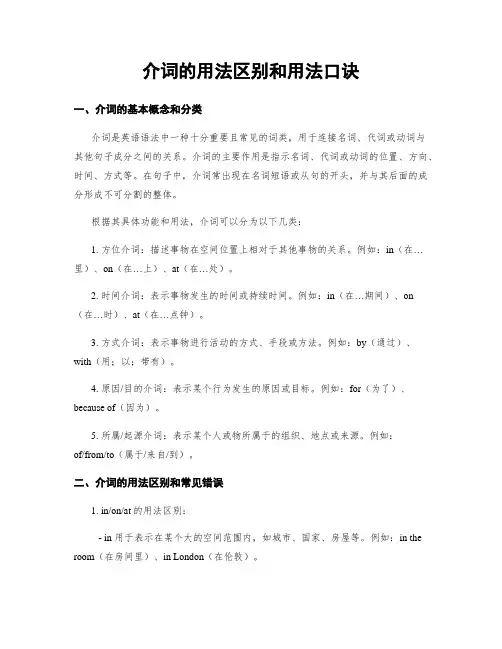
介词的用法区别和用法口诀一、介词的基本概念和分类介词是英语语法中一种十分重要且常见的词类,用于连接名词、代词或动词与其他句子成分之间的关系。
介词的主要作用是指示名词、代词或动词的位置、方向、时间、方式等。
在句子中,介词常出现在名词短语或从句的开头,并与其后面的成分形成不可分割的整体。
根据其具体功能和用法,介词可以分为以下几类:1. 方位介词:描述事物在空间位置上相对于其他事物的关系。
例如:in(在…里)、on(在…上)、at(在…处)。
2. 时间介词:表示事物发生的时间或持续时间。
例如:in(在…期间)、on (在…时)、at(在…点钟)。
3. 方式介词:表示事物进行活动的方式、手段或方法。
例如:by(通过)、with(用;以;带有)。
4. 原因/目的介词:表示某个行为发生的原因或目标。
例如:for(为了)、because of(因为)。
5. 所属/起源介词:表示某个人或物所属于的组织、地点或来源。
例如:of/from/to(属于/来自/到)。
二、介词的用法区别和常见错误1. in/on/at的用法区别:- in 用于表示在某个大的空间范围内,如城市、国家、房屋等。
例如:in the room(在房间里)、in London(在伦敦)。
- on 用于表示在某个平面或表面上,如桌子、地图等。
例如:on the table (在桌子上)、on the map(在地图上)。
- at 用于表示具体位置或地点,常与动词to be连用。
例如:at the bus stop (在公交车站)、at school(在学校)。
2. by/with的区别:- by 表示通过某种方式或手段进行某个行为。
例如:travel by plane(乘坐飞机旅行)、communicate by email(通过电子邮件交流)。
- with 表示使用某种工具或带有某种特征进行活动。
例如:write with a pen (用钢笔写字)、open the door with a key(用钥匙开门)。
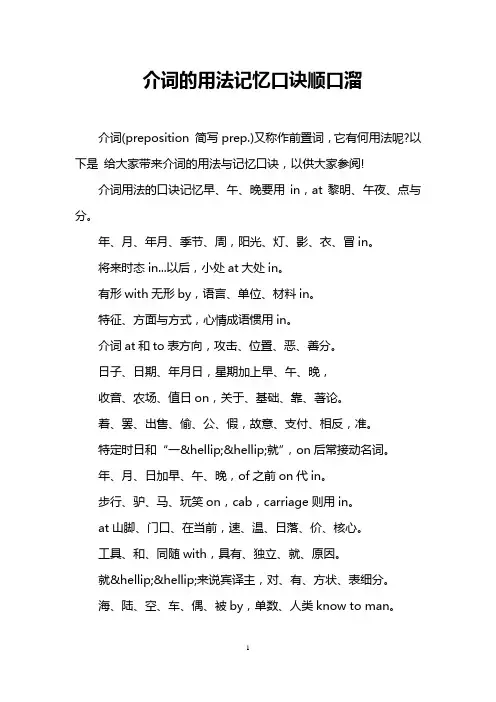
介词的用法记忆口诀顺口溜介词(preposition 简写prep.)又称作前置词,它有何用法呢?以下是给大家带来介词的用法与记忆口诀,以供大家参阅!介词用法的口诀记忆早、午、晚要用in,at黎明、午夜、点与分。
年、月、年月、季节、周,阳光、灯、影、衣、冒in。
将来时态in...以后,小处at大处in。
有形with无形by,语言、单位、材料in。
特征、方面与方式,心情成语惯用in。
介词at和to表方向,攻击、位置、恶、善分。
日子、日期、年月日,星期加上早、午、晚,收音、农场、值日on,关于、基础、靠、著论。
着、罢、出售、偷、公、假,故意、支付、相反,准。
特定时日和“一……就”,on后常接动名词。
年、月、日加早、午、晚,of之前on代in。
步行、驴、马、玩笑on,cab,carriage则用in。
at山脚、门口、在当前,速、温、日落、价、核心。
工具、和、同随with,具有、独立、就、原因。
就……来说宾译主,对、有、方状、表细分。
海、陆、空、车、偶、被by,单数、人类know to man。
this、that、tomorrow,yesterday,next、last、one。
接年、月、季、星期、周,介词省略已习惯。
over、under正上下,above、below则不然,若与数量词连用,混合使用亦无关。
‘beyond超出、无、不能,against靠着,对与反。
besides,except分内外,among之内along沿。
同类比较except,加for异类记心间。
原状because of,、owing to、due to表语形容词under后接修、建中,of、from物、化分。
before、after表一点, ago、later表一段。
before能接完成时,ago过去极有限。
since以来during间,since时态多变换。
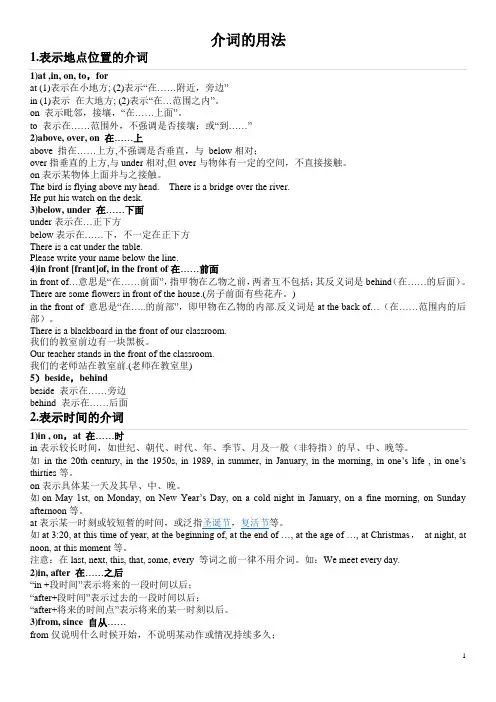
介词的用法1.表示地点位置的介词1)at ,in, on, to,forat (1)表示在小地方; (2)表示“在……附近,旁边”in (1)表示在大地方; (2)表示“在…范围之内”。
on 表示毗邻,接壤,“在……上面”。
to 表示在……范围外,不强调是否接壤;或“到……”2)above, over, on 在……上above 指在……上方,不强调是否垂直,与below相对;over指垂直的上方,与under相对,但over与物体有一定的空间,不直接接触。
on表示某物体上面并与之接触。
The bird is flying above my head. There is a bridge over the river.He put his watch on the desk.3)below, under 在……下面under表示在…正下方below表示在……下,不一定在正下方There is a cat under the table.Please write your name below the line.4)in front [frant]of, in the front of在……前面in front of…意思是“在……前面”,指甲物在乙物之前,两者互不包括;其反义词是behind(在……的后面)。
There are some flowers in front of the house.(房子前面有些花卉。
)in the front of 意思是“在…..的前部”,即甲物在乙物的内部.反义词是at the back of…(在……范围内的后部)。
There is a blackboard in the front of our classroom.我们的教室前边有一块黑板。
Our teacher stands in the front of the classroom.我们的老师站在教室前.(老师在教室里)5)beside,behindbeside 表示在……旁边behind 表示在……后面2.表示时间的介词1)in , on,at 在……时in表示较长时间,如世纪、朝代、时代、年、季节、月及一般(非特指)的早、中、晚等。
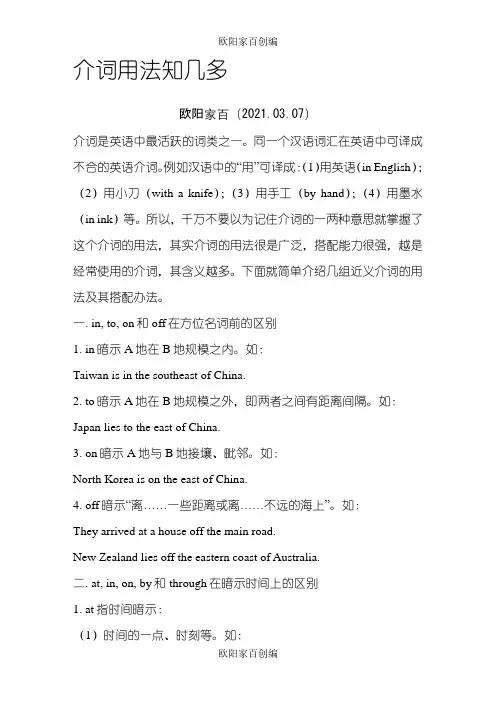
介词用法知几多欧阳家百(2021.03.07)介词是英语中最活跃的词类之一。
同一个汉语词汇在英语中可译成(1)用英语(in English);不合的英语介词。
例如汉语中的“用”可译成:(2)用小刀(with a knife);(3)用手工(by hand);(4)用墨水(in ink)等。
所以,千万不要以为记住介词的一两种意思就掌握了这个介词的用法,其实介词的用法很是广泛,搭配能力很强,越是经常使用的介词,其含义越多。
下面就简单介绍几组近义介词的用法及其搭配办法。
一. in, to, on和off在方位名词前的区别1. in暗示A地在B地规模之内。
如:Taiwan is in the southeast of China.2. to暗示A地在B地规模之外,即两者之间有距离间隔。
如:Japan lies to the east of China.3. on暗示A地与B地接壤、毗邻。
如:North Korea is on the east of China.4. off暗示“离……一些距离或离……不远的海上”。
如:They arrived at a house off the main road.New Zealand lies off the eastern coast of Australia.二. at, in, on, by和through在暗示时间上的区别1. at指时间暗示:(1)时间的一点、时刻等。
如:They came home at sunrise (at noon, at midnight, at ten o’clock, at daybreak, at dawn).(2)较长久的一段时间。
可指某个节日或被认为是一年中标记年夜事的日子。
如:He went home at Christmas (at New Year, at the Spring Festival, at night).2. in指时间暗示:(1)在某个较长的时间(如世纪、朝代、年、月、季节以及泛指的上午、下午或傍晚等)内。
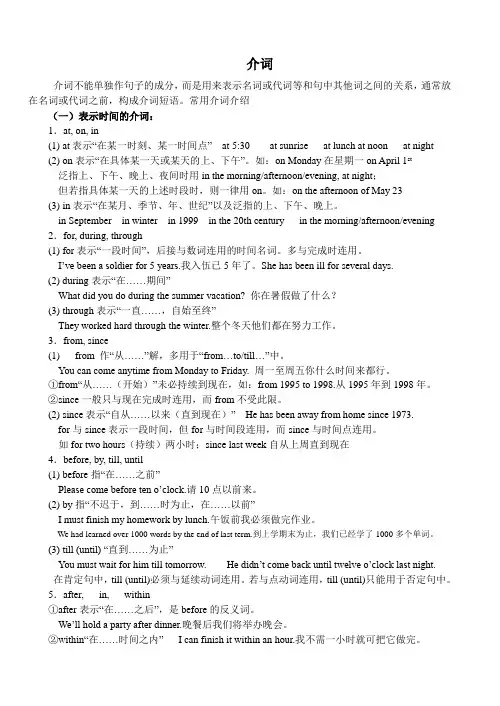
介词介词不能单独作句子的成分,而是用来表示名词或代词等和句中其他词之间的关系,通常放在名词或代词之前,构成介词短语。
常用介词介绍(一)表示时间的介词:1.at, on, in(1) at表示“在某一时刻、某一时间点”at 5:30at sunrise at lunch at noon at night(2) on表示“在具体某一天或某天的上、下午”。
如:on Monday在星期一on April 1st泛指上、下午、晚上、夜间时用in the morning/afternoon/evening, at night;但若指具体某一天的上述时段时,则一律用on。
如:on the afternoon of May 23(3) in表示“在某月、季节、年、世纪”以及泛指的上、下午、晚上。
in September in winter in 1999in the 20th century in the morning/afternoon/evening 2.for, during, through(1) for表示“一段时间”,后接与数词连用的时间名词。
多与完成时连用。
I’ve been a soldier for 5 years.我入伍已5年了。
She has been ill for several days.(2) during表示“在……期间”What did you do during the summer vacation? 你在暑假做了什么?(3) through表示“一直……,自始至终”They worked hard through the winter.整个冬天他们都在努力工作。
3.from, since(1)from 作“从……”解,多用于“from…to/till…”中。
You can come anytime from Monday to Friday. 周一至周五你什么时间来都行。
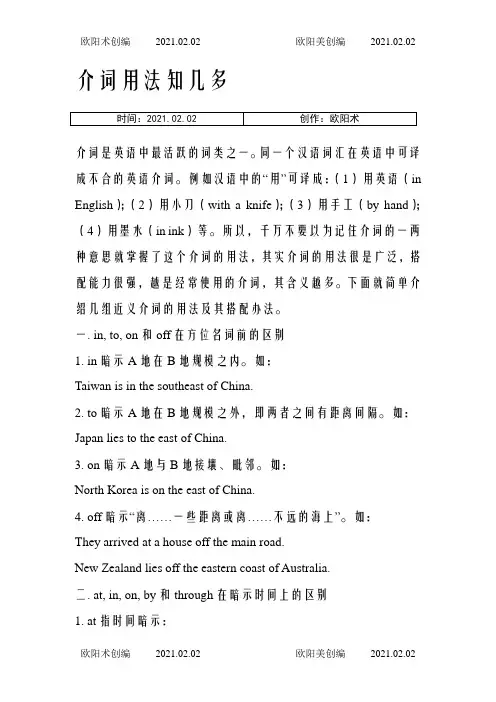
介词用法知几多介词是英语中最活跃的词类之一。
同一个汉语词汇在英语中可译成不合的英语介词。
例如汉语中的“用”可译成:(1)用英语(in English);(2)用小刀(with a knife);(3)用手工(by hand);(4)用墨水(in ink)等。
所以,千万不要以为记住介词的一两种意思就掌握了这个介词的用法,其实介词的用法很是广泛,搭配能力很强,越是经常使用的介词,其含义越多。
下面就简单介绍几组近义介词的用法及其搭配办法。
一. in, to, on和off在方位名词前的区别1. in暗示A地在B地规模之内。
如:Taiwan is in the southeast of China.2. to暗示A地在B地规模之外,即两者之间有距离间隔。
如:Japan lies to the east of China.3. on暗示A地与B地接壤、毗邻。
如:North Korea is on the east of China.4. off暗示“离……一些距离或离……不远的海上”。
如:They arrived at a house off the main road.New Zealand lies off the eastern coast of Australia.二. at, in, on, by和through在暗示时间上的区别1. at指时间暗示:(1)时间的一点、时刻等。
如:They came home at sunrise (at noon, at midnight, at ten o’clock, at daybreak, at dawn).(2)较长久的一段时间。
可指某个节日或被认为是一年中标记年夜事的日子。
如:He went home at Christmas (at New Year, at the Spring Festival, at night).2. in指时间暗示:(1)在某个较长的时间(如世纪、朝代、年、月、季节以及泛指的上午、下午或傍晚等)内。
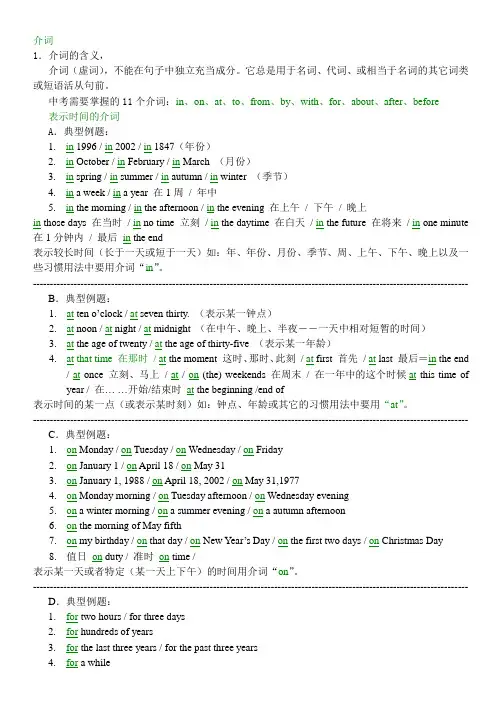
介词1.介词的含义,介词(虚词),不能在句子中独立充当成分。
它总是用于名词、代词、或相当于名词的其它词类或短语活从句前。
中考需要掌握的11个介词:in、on、at、to、from、by、with、for、about、after、before表示时间的介词A.典型例题:1.in 1996 / in 2002 / in 1847(年份)2.in October / in February / in March (月份)3.in spring / in summer / in autumn / in winter (季节)4.in a week / in a year 在1周/ 年中5.in the morning / in the afternoon / in the evening 在上午/ 下午/ 晚上in those days 在当时/ in no time 立刻/ in the daytime 在白天/ in the future 在将来/ in one minute 在1分钟内/ 最后in the end表示较长时间(长于一天或短于一天)如:年、年份、月份、季节、周、上午、下午、晚上以及一些习惯用法中要用介词“in”。
-------------------------------------------------------------------------------------------------------------------------------- B.典型例题:1.at ten o’clock / at seven thirty. (表示某一钟点)2.at noon / at night / at midnight (在中午、晚上、半夜――一天中相对短暂的时间)3.at the age of twenty / at the age of thirty-five (表示某一年龄)4.at that time 在那时/ at the moment 这时、那时、此刻/ at first 首先/ at last 最后=in the end/ at once 立刻、马上/ at / on (the) weekends 在周末/ 在一年中的这个时候at this time of year / 在……开始/结束时at the beginning /end of表示时间的某一点(或表示某时刻)如:钟点、年龄或其它的习惯用法中要用“at”。
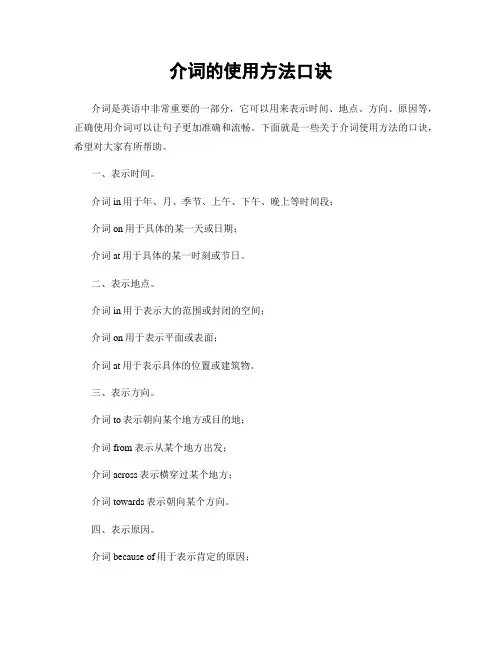
介词的使用方法口诀介词是英语中非常重要的一部分,它可以用来表示时间、地点、方向、原因等,正确使用介词可以让句子更加准确和流畅。
下面就是一些关于介词使用方法的口诀,希望对大家有所帮助。
一、表示时间。
介词in用于年、月、季节、上午、下午、晚上等时间段;介词on用于具体的某一天或日期;介词at用于具体的某一时刻或节日。
二、表示地点。
介词in用于表示大的范围或封闭的空间;介词on用于表示平面或表面;介词at用于表示具体的位置或建筑物。
三、表示方向。
介词to表示朝向某个地方或目的地;介词from表示从某个地方出发;介词across表示横穿过某个地方;介词towards表示朝向某个方向。
四、表示原因。
介词because of用于表示肯定的原因;介词due to用于表示中性的原因;介词owing to用于表示正式的原因;介词thanks to用于表示积极的原因。
五、其他常用介词。
介词by表示通过某种方式或工具;介词with表示伴随或使用某物;介词for表示为了某种目的或代表某人。
六、特殊用法。
介词in、on、at在特定搭配中有特殊用法,需要根据具体情况进行记忆和理解。
七、总结。
介词的使用方法口诀并非一成不变,需要根据具体语境进行灵活运用。
通过大量的阅读和实践,逐渐掌握介词的用法是非常重要的。
以上就是介词的使用方法口诀,希望对大家有所帮助。
在学习英语的过程中,多多积累、多多练习,相信大家一定能够掌握好介词的使用方法,写出更加地道和流畅的英语句子。
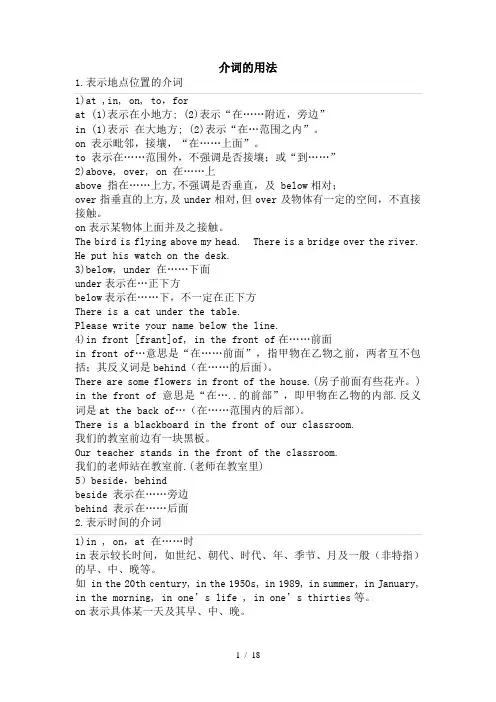
介词的用法1.表示地点位置的介词1)at ,in, on, to,forat (1)表示在小地方; (2)表示“在……附近,旁边”in (1)表示在大地方; (2)表示“在…范围之内”。
on 表示毗邻,接壤,“在……上面”。
to 表示在……范围外,不强调是否接壤;或“到……”2)above, over, on 在……上above 指在……上方,不强调是否垂直,及 below相对;over指垂直的上方,及under相对,但over及物体有一定的空间,不直接接触。
on表示某物体上面并及之接触。
The bird is flying above my head. There is a bridge over the river. He put his watch on the desk.3)below, under 在……下面under表示在…正下方below表示在……下,不一定在正下方There is a cat under the table.Please write your name below the line.4)in front [frant]of, in the front of在……前面in front of…意思是“在……前面”,指甲物在乙物之前,两者互不包括;其反义词是behind(在……的后面)。
There are some flowers in front of the house.(房子前面有些花卉。
) in the front of 意思是“在…..的前部”,即甲物在乙物的内部.反义词是at the back of…(在……范围内的后部)。
There is a blackboard in the front of our classroom.我们的教室前边有一块黑板。
Our teacher stands in the front of the classroom.我们的老师站在教室前.(老师在教室里)5)beside,behindbeside 表示在……旁边behind 表示在……后面2.表示时间的介词1)in , on,at 在……时in表示较长时间,如世纪、朝代、时代、年、季节、月及一般(非特指)的早、中、晚等。
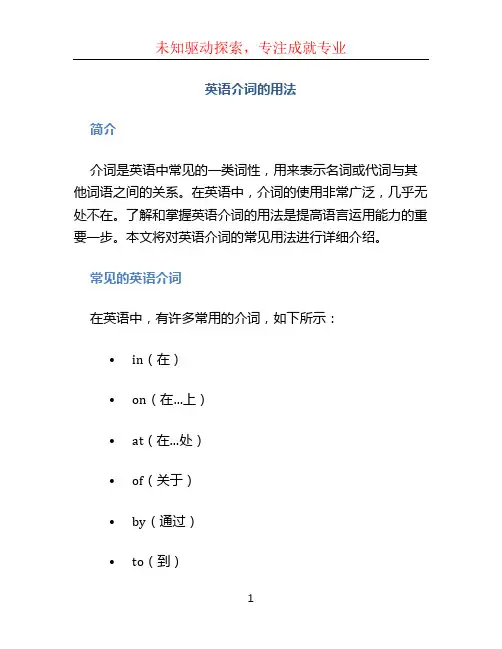
英语介词的用法简介介词是英语中常见的一类词性,用来表示名词或代词与其他词语之间的关系。
在英语中,介词的使用非常广泛,几乎无处不在。
了解和掌握英语介词的用法是提高语言运用能力的重要一步。
本文将对英语介词的常见用法进行详细介绍。
常见的英语介词在英语中,有许多常用的介词,如下所示:•in(在)•on(在…上)•at(在…处)•of(关于)•by(通过)•to(到)•for(为了)•with(与…一起)•from(从…来)•about(关于)•among(在…之中)•between(在…之间)这些介词在日常生活和学习中经常被用到,我们需要了解其用法和搭配。
介词的基本用法介词通常与名词或代词一起构成介词短语,表示位置、方向、时间、原因、方式等关系。
下面是一些常见的用法示例:1.表示位置关系–The book is on the table.(这本书在桌子上。
)–My house is in the city.(我的房子在城市里。
)–He is standing behind the door.(他站在门后。
)2.表示方向关系–I’m going to the supermarket.(我去超市。
)–She walked towards the park.(她朝着公园走去。
)–The train is coming from the north.(火车是从北方来的。
)3.表示时间关系–We have a meeting at10 o’clock.(我们在10点开会。
)–He usually sleeps during the day.(他通常在白天睡觉。
)–The party will be held on Saturday.(派对将于星期六举行。
)4.表示原因和目的–She went to the library for studying.(她去图书馆是为了学习。
)–He apologized for his mistake.(他为自己的错误道歉。
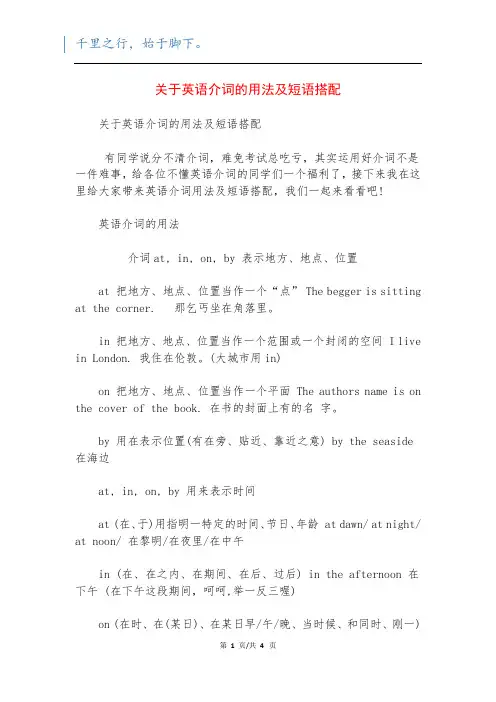
关于英语介词的用法及短语搭配关于英语介词的用法及短语搭配有同学说分不清介词,难免考试总吃亏,其实运用好介词不是一件难事,给各位不懂英语介词的同学们一个福利了,接下来我在这里给大家带来英语介词用法及短语搭配,我们一起来看看吧!英语介词的用法介词at, in, on, by 表示地方、地点、位置at 把地方、地点、位置当作一个“点” The begger is sitting at the corner. 那乞丐坐在角落里。
in 把地方、地点、位置当作一个范围或一个封闭的空间 I live in London. 我住在伦敦。
(大城市用in)on 把地方、地点、位置当作一个平面 The authors name is on the cover of the book. 在书的封面上有的名字。
by 用在表示位置(有在旁、贴近、靠近之意) by the seaside 在海边at, in, on, by 用来表示时间at (在、于)用指明一特定的时间、节日、年龄 at dawn/ at night/ at noon/ 在黎明/在夜里/在中午in (在、在之内、在期间、在后、过后) in the afternoon 在下午 (在下午这段期间,呵呵,举一反三喔)on (在时、在(某日)、在某日早/午/晚、当时候、和同时、刚一)on the first 在一号(指某月一号,如二号要说second等。
其实意思是指某月的第几天)by (的时候、到、等到已经) 用在天、时间 by 2 oclock 到两点钟for, since 用于表示时间用 for 用计量时间(年、月、日、时、分、秒等) He held his breath for five minutes. 他闭息达五分钟。
用 since 表示明确的日期或时间 Hes woked here since 1980. 自从1970年他就在此工作。
表示动作的介词:to ,toward或不用介词用 to 表示向某处移动 They were driving to work together. 他们一同开车去工作。
英语介词的含义及其用法介词的知识点有哪些英语介词的含义及其用法介词是英语语法中的重要部分,用于连接名词、代词、动词或其他词组,以表达它们之间的关系。
介词通常放置在名词或代词之前,并且与它们一起构成短语。
本文将探讨英语介词的含义及其用法,帮助读者更好地理解和运用介词。
一、介词的含义介词用于表示词与词之间、短语与短语之间、或者句子与句子之间的关系。
它可以表达时间、地点、方向、原因、目的、手段等方面的含义。
常见的介词包括in、on、at、from、to、with、by、for等,它们各自有不同的用法和含义。
二、表示时间的介词1. at:表示具体的时间点,如at 7 o'clock(在7点钟)。
2. on:表示某一天或具体日期,如on Monday(在星期一)、on July 1st(在7月1日)。
3. in:表示一段时间,如in the morning(在早上)、in June(在六月)。
三、表示地点的介词1. in:表示大的地区或范围,如in China(在中国)、in the room (在房间里)。
2. on:表示平面上的位置,如on the table(在桌子上)。
3. at:表示具体的地点,如at the park(在公园)。
四、表示方向的介词1. to:表示朝向某个地方或目标,如go to school(去学校)。
2. from:表示从某个地方出发,如come from China(来自中国)。
3. into:表示进入某个地方,如go into the house(进入房子)。
五、表示原因和目的的介词1. for:表示目的或用途,如for studying(为了学习)。
2. because of:表示因为,如because of the rain(因为下雨)。
六、表示手段的介词1. with:表示使用某种手段,如write with a pen(用钢笔写)。
2. by:表示通过某种手段,如travel by plane(乘飞机旅行)。
关于英语介词的用法及短语搭配有同学说分不清介词,难免考试总吃亏,其实运用好介词不是一件难事,给各位不懂英语介词的同学们一个福利了,接下来小编在这里给大家带来英语介词用法及短语搭配,我们一起来看看吧!英语介词的用法介词at, in, on, by 表示地方、地点、位置at 把地方、地点、位置当作一个“点” The begger is sitting at the corner. 那乞丐坐在角落里。
in 把地方、地点、位置当作一个范围或一个封闭的空间I live in London. 我住在伦敦。
(大城市用in)on 把地方、地点、位置当作一个平面 The author's name is on the cover of the book. 在书的封面上有作者的名字。
by 用在表示位置(有在旁、贴近、靠近之意) by the seaside 在海边at, in, on, by 用来表示时间at (在、于)用指明一特定的时间、节日、年龄 at dawn/ at night/ at noon/ 在黎明/在夜里/在中午in (在、在…之内、在…期间、在…后、过…后) in the afternoon 在下午 (在下午这段期间,呵呵,举一反三喔)on (在…时、在(某日)、在某日早/午/晚、当…时候、和…同时、刚一…) on the first在一号(指某月一号,如二号要说second等。
其实意思是指某月的第几天)by (的时候、到、等到…已经) 用在天、时间 by 2 o'clock 到两点钟for, since 用于表示时间用for 用计量时间(年、月、日、时、分、秒等) He held his breath for five minutes. 他闭息达五分钟。
用since 表示明确的日期或时间He's woked here since 1980. 自从1970年他就在此工作。
表示动作的介词:to ,toward或不用介词用 to 表示向某处移动 They were driving to work together. 他们一同开车去工作。
介词知识点总结简洁易懂一、介词的基本概念介词是一种虚词,它通常位于名词、代词或动词前面,用来引导名词短语或介词短语。
在句子中,介词起着连接成分的作用,可以表示时间、地点、方向、原因、方式、目的等各种关系。
常见的介词包括in, on, at, to, of, for, with, by, from等。
二、介词的用法1. 表示时间介词在表示时间方面有着重要的作用,比如:- on用于特定的日期或日子,如on Monday, on New Year's Day;- in用于月份、季节、年份或一段时间内,如in April, in winter, in 2022, in a week;- at用于具体的时间点,如at 3 o'clock, at midnight, at noon。
2. 表示地点介词也常常用来表示地点、位置,比如:- in用于大的范围或容器内,如in the city, in a box;- on用于较小的表面或物体上,如on the table, on the wall;- at用于具体的地点或建筑物,如at the station, at the bus stop。
3. 表示方向有些介词还可以表示方向,比如to表示朝着某个地方,from表示从某个地方出发,through表示穿越,等等。
4. 表示原因、方式、目的介词还可以表示原因、方式、目的等各种关系,如by表示通过某种方式,for表示为了某个目的,with表示带着某样东西,等等。
三、介词的常见搭配在英语中,很多介词都有着固定的搭配,例如:- be interested in对……感兴趣- be good at擅长于- be angry with对……生气- be afraid of害怕……- be proud of为……感到自豪- be similar to类似于……这些固定搭配需要大家多加练习,以便熟练掌握。
四、介词的注意事项在使用介词时,也需要注意一些特殊的地方,比如:- 介词的选择受到上下文的影响,有时候需要根据具体情况选择适当的介词;- 一些动词后面必须搭配特定的介词,例如look forward to, depend on, consist of等;- 介词的错误使用会导致句子不通顺,因此需要多加注意。
1 介词 介词 In; on, at; after, until; before;during; by; to; for;between ;with; about;from in (1)表示时间段,在相当长的一段时间 in the morning , in the evening
(2)在未来的一段时间内 in a month, in a year, in a week
(3)在...里面 in the classroom, in the building
(4)在大的地点 in a country, in a village
on (1)表示具体的日期或星期 on Monday, on my birthay, on the wedding anniversary
(2)表示特定某一天的上午、下午、凌晨或半夜。 On the
night/morning/afternoon of December31,1999 on the eve of Christmas on a cold afternoon in January
(3)表示在第几天 on his first day to school on the tenth day I was in Beijing.
at at (主要表示时间) 在某一时刻 at 9:00 at 9:10
表示不确定的某一时段 at night at dawn at that time at the moment at the end of
表示年龄阶段 at the age of He got married at twenty. 表示地点 在家 ________ 在学校____________ 在办公室______________ 2
在诊所_________________ by 表示行为方式 send something by post do something by
英语中所有介词的用法
介词是一种用来连接名词、代词、动词或其他词与其前面的词之间关系的词类。
下面是一些常见的介词及其用法:
1. in(在、在…之内):表示位置,如in the room(在房间里);也表示时间,在未来;也可以用来表示状态,如in trouble(有麻烦)。
2. on(在、在…上):表示接触,如on the table(在桌子上);表示时间,如on Monday(在星期一);也可以表示方式,如on foot(步行)。
3. at(在、在…时):表示位置,如at the park(在公园);
表示时间,如at 6 o'clock(在六点钟)。
4. by(通过、靠近):表示方式,如by taxi(乘坐出租车);也表示靠近,在旁边;还可以表示时间,如by June(到六月
之前)。
5. for(为、给):表示目的或原因,如study for a test(为考
试而学习);也表示时间段,如for two weeks(两周)。
6. with(和、用):表示具有某种特征,如a girl with blue
eyes(有蓝眼睛的女孩);也可以表示通过某种方式、手段,
如write with a pen(用钢笔写)。
7. from(从、来自):表示出处,如from the store(从商店
里);表示起点,如from London(从伦敦)。
8. to(到、向):表示目的地,如go to school(去学校);表示方向,如face to the north(面朝北方)。
这只是一部分介词的使用方法,介词的用法还有很多,需要根据具体语境来理解和运用。
介词at, by, to, in, for, of, on, from, with其中又以at, by, in, on为四大“要犯”!学习介词就是要抓住这几“要犯”。
有人写了一首《介词口诀》来帮助学习者;也有人写了《Preposition Song》令学习者一面唱歌一面轻松地记忆介词的用法。
同学们可以借助这个方法有针对性地记忆常用介词:1. In the summer at the seaside (季节用in, 在海边用at)On the coast we like it fine (在海岸用on)but in winter ,yes ,at Christmas (在圣诞用at)By the fireside we recline (放置) (在炉边用by)2. In July we went to Kenya (月份用in)Stayed in Lamu by the sea, (住在Lamu用in)We came back to TanzaniaThen across Victoria sea3. Did you come here in a taxi? (乘出租汽车用in)Or by bus, or on the train? (乘公共汽车用by, 乘火车用on) Did you come on foot this evening (步行用on)Or perhaps by aeroplane? (乘飞机用by)4. Will you come to tea on Monday? (在星期一用on)I′ll be home at half past three(时间三点半用at)Yes, I′ll stay for half an hour (长达半小时用for)if you buy some beer for me (给我for me)5. In the morning I drink coffee (早晨用in the morning)In the afternoon there′s tea(下午用in the afternoon)In the evening I have cocoa (傍晚用in the evening)Yes, at night ,it′s good for me.(晚上用at night)6. Where′s my pencil?In the kitchen(厨房里in the kitchen) On the table near the chair (在桌上on the table, 在椅边near the chair)Underneath the cup and saucer (在杯和碟的下面 underneath...) Just behind the teapot there (在茶壶后边behind...)7. Can you tell me how to get toMr. Johnson′s coffee-bar?Down the street and round the corner (down the street 沿着街道,round...绕过)Past the church and there you are8. Where′s the bookshop? Over there,dear (over there 那里) First turn left,then go straight on,Along the road,across the market (沿着路along the road, 穿过市场 across...)It′s in front of you, dear John(在你前面 in front of you) 9. There is nothing on the radio (广播on the radio) "Songs with orchestra" they said. (with后orchestra为有形物,无形物则用by)I′m not interested in music(interested in 兴趣于)s o I think I′ll go to bed10. In a moment I′ll be finished(in a moment 片刻里) With these prepositions-so I will say to you in English till the next time, cheerio (加油呀) (till... 直到)记住这十段歌词后,你就学到许多介词用法了。
其中包括四大“要犯”at, by, in,on。
四个介词:at,in,on,by用法。
二、介词at, in, on, by 表示地方、地点、位置:at 把地方、地点、位置当作一个“点”:1. The begger is sitting at the corner. 那乞丐坐在角落里。
2. Jane is waiting for you at the bus stop. Jane在巴士站等你。
3. at home 在家4. Who’s standing there at the door? 谁站在门口?5. at the top of the page 在一页的上面6. The shop is at the end of the road. 那商店就在路的尾端。
7. at the entrance 在进口处8. at the crossroads 在十字路口9. When will you arrive at the office? 你什么时候会到公司呢?10. I’m in France, at Paris. 我住在法国巴黎。
(相对法国来讲,巴黎只是一个“点”)11. There is a small hut at the foot of the hill. 山脚下有一座小屋子。
12. My aunt lives at 55 Boretz Road in Durham.我的姑妈住在Durham,Boretz 路门牌55号。
(地址要用at,不能用in)13. at the side 在一边14. at reception 在招待会上15. I’m at work.我在工作。
16. at class/ home/ the library/ the office/ school 在班上/家里/图书馆/公司/学校in 把地方、地点、位置当作一个范围或一个封闭的空间:1. I live in London. 我住在伦敦。
(大城市用in)2. I live in England, at London. 我住在英国伦敦。
(England 大过London喔)3. I live in a big city, my sister lives at a small town. 我住在大城市,我姐姐住在一个小市镇。
(如果把city看做一个圆圈,small town就成一个点。
因此就ina city, at a small town. 呵呵)4. We have a meeting in Beijing. 我们有北京有一个会议。
5. Mars is in the Solar System. 火星在太阳系里。
6. in a car 乘汽车 (不是 on a car 也不是 by a car 喔)7. in a taxi 乘的士 (不是 on a taxi 或 by a taxi )8. in a helicopter 乘直升机9. in a boat 乘小船10. in a lift (elevator) 乘电梯 (电梯像个笼子,当然要用 in 啦)11. in the newspaper 在报上12. in the sky 在空中14. in the bedroom/ class/ library/ school 在寝室/课室/图书馆/学校on 把地方、地点、位置当作一个平面:1 The author’s name is on the cover of the book 在书的封面上有作者的名字。
2. There are no prices on this menu. 在这菜单上没有价钱。
3. You are standing on my foot. 你踏到我的脚了。
4. There was a "no smoking" sign on the wall. 在那墙上有个“不准吸烟”的牌子。
5. I live on the 7th floor at 21 Oxford Street in London. 我住在伦敦牛津街21号八楼。
(7th floor 就是八楼;注意句中的 on, at, in 的用法)6. on a bus 乘巴士 (不是 in a bus 喔)7. on a train 乘火车 (可想像“骑”在火车上,哈哈)8. on a plane 乘飞机 (可想像“骑”在飞机上)9. on a ship 乘轮船10. on a bicycle, on a motorbike 骑自行车/摩托车11. on a horse, on an elephant 骑马/象12. on the radio, on television 听广播、看电视13. on the left, on the right 在左边、在右边14. on the way 在路上16. on the ceiling 在天花板上17. on the floor 在地板上by 用在表示位置(有在旁、贴近、靠近之意):1. by the fire 在炉边2. by the seaside 在海边3. a path by the river 沿河道路4. by the nearest road 走近路要记忆介词的用法,就得用一点想象力加以联想。
如:at home, at the door, atthe corner等等,可想象“at家门口的角落里”。
再比如: in Beijing, in a car, ina taxi, in a boat, in a helicopter, in the sky ... 可想象为“In 北京,乘汽车,乘的士,再乘小船,乘上直升机在空中飞”。
at, in, on, by 用来表示时间at (在、于)用指明一特定的时间、节日、年龄:1. at dawn/ at night/ at noon/ at midnight /at daybreak在黎明/在夜里/在中午/在午夜/在日出时2. I go to school at seven in the morning. (at seven) 我早上七点钟去上学。